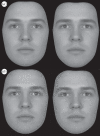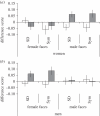Exposure to visual cues of pathogen contagion changes preferences for masculinity and symmetry in opposite-sex faces
- PMID: 21123269
- PMCID: PMC3107643
- DOI: 10.1098/rspb.2010.1925
Exposure to visual cues of pathogen contagion changes preferences for masculinity and symmetry in opposite-sex faces
Abstract
Evolutionary approaches to human attractiveness have documented several traits that are proposed to be attractive across individuals and cultures, although both cross-individual and cross-cultural variations are also often found. Previous studies show that parasite prevalence and mortality/health are related to cultural variation in preferences for attractive traits. Visual experience of pathogen cues may mediate such variable preferences. Here we showed individuals slideshows of images with cues to low and high pathogen prevalence and measured their visual preferences for face traits. We found that both men and women moderated their preferences for facial masculinity and symmetry according to recent experience of visual cues to environmental pathogens. Change in preferences was seen mainly for opposite-sex faces, with women preferring more masculine and more symmetric male faces and men preferring more feminine and more symmetric female faces after exposure to pathogen cues than when not exposed to such cues. Cues to environmental pathogens had no significant effects on preferences for same-sex faces. These data complement studies of cross-cultural differences in preferences by suggesting a mechanism for variation in mate preferences. Similar visual experience could lead to within-cultural agreement and differing visual experience could lead to cross-cultural variation. Overall, our data demonstrate that preferences can be strategically flexible according to recent visual experience with pathogen cues. Given that cues to pathogens may signal an increase in contagion/mortality risk, it may be adaptive to shift visual preferences in favour of proposed good-gene markers in environments where such cues are more evident.
Figures


Similar articles
-
Microbes and masculinity: Does exposure to pathogenic cues alter women's preferences for male facial masculinity and beardedness?PLoS One. 2017 Jun 8;12(6):e0178206. doi: 10.1371/journal.pone.0178206. eCollection 2017. PLoS One. 2017. PMID: 28594843 Free PMC article.
-
Correlated male preferences for femininity in female faces and voices.Evol Psychol. 2010 Aug 9;8(3):447-61. doi: 10.1177/147470491000800311. Evol Psychol. 2010. PMID: 22947812 Free PMC article.
-
Men's preferences for women's femininity in dynamic cross-modal stimuli.PLoS One. 2013 Jul 31;8(7):e69531. doi: 10.1371/journal.pone.0069531. Print 2013. PLoS One. 2013. PMID: 23936037 Free PMC article. Clinical Trial.
-
Non-Pregnant and Pregnant Women's Femininity Preferences in Male Faces: Tests Based on Within- and Between-Sex Sexual Dimorphism Facial Manipulations.Arch Sex Behav. 2021 Feb;50(2):531-541. doi: 10.1007/s10508-020-01868-8. Epub 2021 Jan 4. Arch Sex Behav. 2021. PMID: 33398708 Free PMC article.
-
Facial attractiveness: evolutionary based research.Philos Trans R Soc Lond B Biol Sci. 2011 Jun 12;366(1571):1638-59. doi: 10.1098/rstb.2010.0404. Philos Trans R Soc Lond B Biol Sci. 2011. PMID: 21536551 Free PMC article. Review.
Cited by
-
Do men's faces really signal heritable immunocompetence?Behav Ecol. 2013 May;24(3):579-589. doi: 10.1093/beheco/ars092. Epub 2012 Oct 24. Behav Ecol. 2013. PMID: 23555177 Free PMC article.
-
Differential effects of resource scarcity and pathogen prevalence on heterosexual women's facial masculinity preferences.Evol Hum Sci. 2021 Sep 16;3:e48. doi: 10.1017/ehs.2021.42. eCollection 2021. Evol Hum Sci. 2021. PMID: 37588556 Free PMC article.
-
Mate assessment based on physical characteristics: a review and reflection.Biol Rev Camb Philos Soc. 2025 Feb;100(1):113-130. doi: 10.1111/brv.13131. Epub 2024 Aug 22. Biol Rev Camb Philos Soc. 2025. PMID: 39175167 Free PMC article. Review.
-
The sociality-health-fitness nexus: synthesis, conclusions and future directions.Philos Trans R Soc Lond B Biol Sci. 2015 May 26;370(1669):20140115. doi: 10.1098/rstb.2014.0115. Philos Trans R Soc Lond B Biol Sci. 2015. PMID: 25870401 Free PMC article. Review.
-
Preference for Male Risk Takers Varies with Relationship Context and Health Status but not COVID Risk.Evol Psychol Sci. 2023 Feb 22:1-10. doi: 10.1007/s40806-023-00354-3. Online ahead of print. Evol Psychol Sci. 2023. PMID: 36845029 Free PMC article.
References
-
- Thornhill R., Gangestad S. W. 1999. Facial attractiveness. Trends Cogn. Sci. 3, 452–46010.1016/S1364-6613(99)01403-5 (doi:10.1016/S1364-6613(99)01403-5) - DOI - DOI - PubMed
-
- Jasienska G., Lipson S. F., Ellison P. T., Thune I., Ziomkiewicz A. 2006. Symmetrical women have higher potential fertility. Evol. Hum. Behav. 27, 390–40010.1016/j.evolhumbehav.2006.01.001 (doi:10.1016/j.evolhumbehav.2006.01.001) - DOI - DOI
-
- Møller A. P., Thornhill R. 1998. Bilateral symmetry and sexual selection: a meta-analysis. Am. Nat. 151, 174–19210.1086/286110 (doi:10.1086/286110) - DOI - DOI - PubMed
-
- Thornhill R., Gangestad S. W. 2006. Facial sexual dimorphism, developmental stability, and susceptibility to disease in men and women. Evol. Hum. Behav. 27, 131–14410.1016/j.evolhumbehav.2005.06.001 (doi:10.1016/j.evolhumbehav.2005.06.001) - DOI - DOI
-
- Weeden J., Sabini J. 2005. Physical attractiveness and health in western societies: a review. Psychol. Bull. 131, 635–65310.1037/0033-2909.131.5.635 (doi:10.1037/0033-2909.131.5.635) - DOI - DOI - PubMed
MeSH terms
LinkOut - more resources
Full Text Sources
Medical

